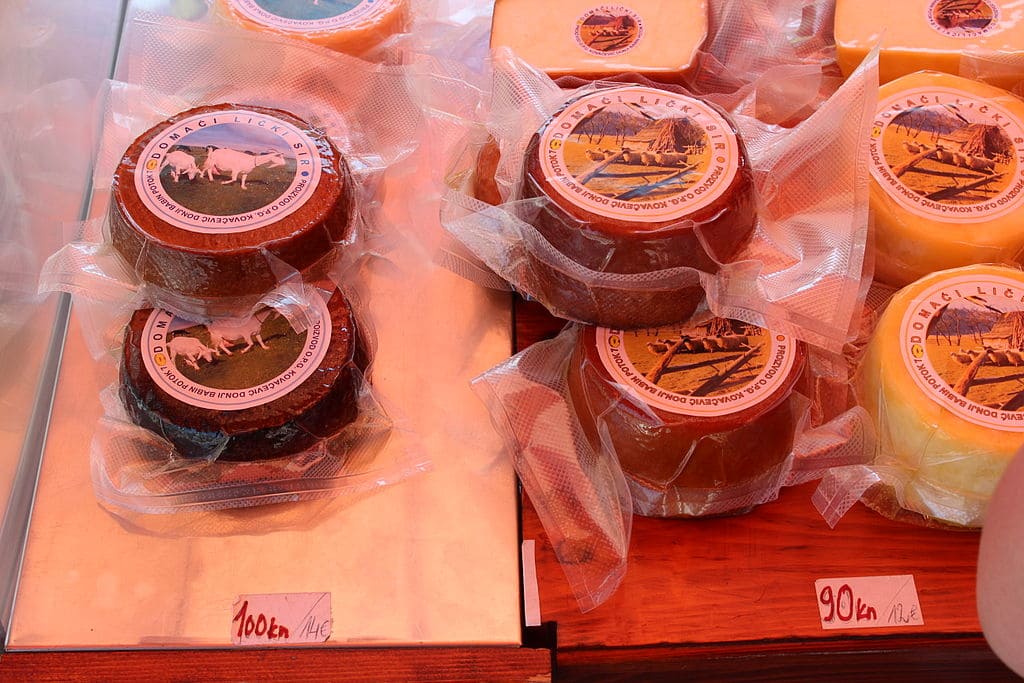
Wedged between Central Europe, Southeast Europe, and the Mediterranean, Croatia is in a unique position of influence among its neighbors. With a history as long and hard to follow as many of its surrounding European countries, Croatia has seen influence everywhere from Yugoslavia to the Habsburg Monarchy to the Ottoman Empire. No wonder then, that Croatian cuisine exemplifies a similar melting pot mentality.
However while some countries take cheesemaking tips from their neighbors, Croatian cheese is largely unique.
While the casual cheese lover might scratch their head at the mention of Croatian curds, the country has been establishing itself as a global cheese leader in recent years. At the 2016 World Cheese Awards, it was a Croatian creation that was named best cheese in Central and Eastern Europe, as well as receiving a score of 99.90 in the hard sheep’s milk cheese category. In a competition of over 3,000 cheeses, this distinction is nothing to scoff at.
Paški sir, or Pag Island cheese, has been a local favorite for decades, but has only recently stepped into the international spotlight. The island of Pag itself is lauded as providing all the secret ingredients that make the delicious cheese so unique. Located in the Adriatic, Pag island has produced sea salt, honey, herbs, and wool for centuries. Sheep have been a part of the inhabitants’ way of life for longer than anyone can remember, and form the basis of Pag’s cheese empire.

Photo Credit: Isiwal | Wikimedia Commons
The Pag sheep graze on a variety of aromatic wild herbs, including sage, which contributes a unique flavor to their milk. The sea salt that blows all over the island is also a factor, both to the milk and the formed wheels. After the cheese is made, it’s aged for between 4 months and 1.5 years before being submerged in olive oil and rubbed in ash.
The result is a dry and flaky aged cheese that showcases the saltiness and aromatic herbal elements derived from the island. A point of pride throughout Croatia, Paški sir can be found as a starter (usually with olives, fresh fruit, or honey) or blended into risotto at restaurants all over the country.
Travel blogger Matt Long of Landlopers claims Pag cheese is “the best cheese you’ve never heard of.” A trip to Zagreb introduced him to the regional delicacy, and after a brief love affair with the dairy, he headed to Pag Island to see the production process for himself. Beyond a delicious appetizer, Matt explains that the cheese “came to personally symbolize the culinary traditions in Croatia” for him. For many Croatians the cheese is a point of patriotism and pride, an internationally renowned symbol showcasing the country’s culinary tradition.

Photo Credit: Apostoloff | Wikimedia Commons
Although the most famous, Paški Sir is certainly not the only cheese in Croatia. Sirene is a fresh, white, brined cheese produced in a string of countries across South-Eastern Europe. Showcasing clear coastal Mediterranean influence, the cheese closely resembles Feta, even earning the nickname Bulgarian Feta. The cheese can be made of any combination of goat’s, cow’s, or sheep’s milk, the composition of which often depends on the region or country of origin.
In Croatia, the cheese has earned a place of distinction for its ease of production and loose definition, and is often served as a table cheese or in salads and baking. Sirene is a common addition in everything from eggs to pasta to soups, which explains how common it is throughout the region.
Although Paški Sir and sirene are lauded as two of the country’s most popular cheeses, Croatia boasts a host of even less pronounceable cheeses, from Dinarski to Tezacki to Liburnski. While they might currently be unknown, Croatian cheeses have proven themselves to be unique and worthy of notice in the years that they’ve been on the world stage, and will surely continue to do so in the coming years.
Featured image: Wikiarius | Wikipedia Commons



